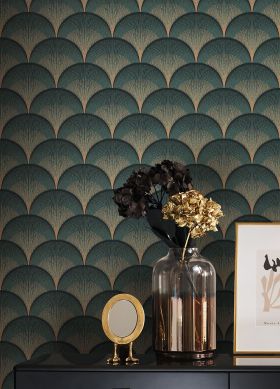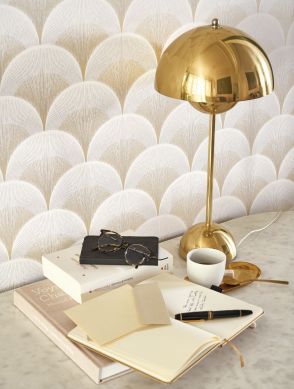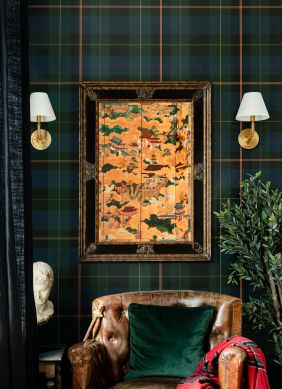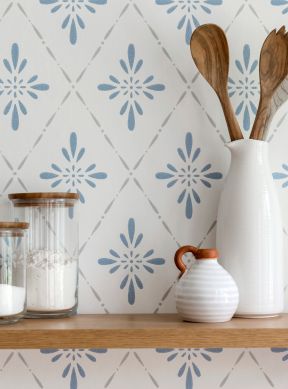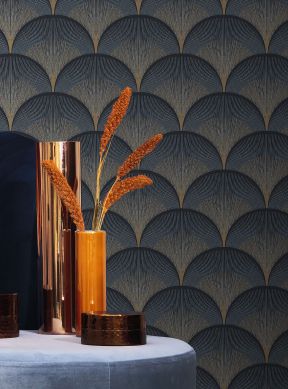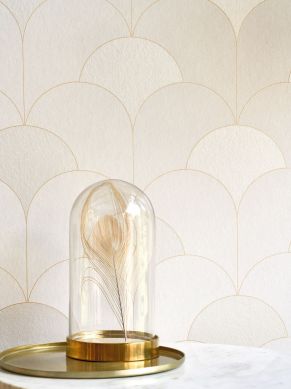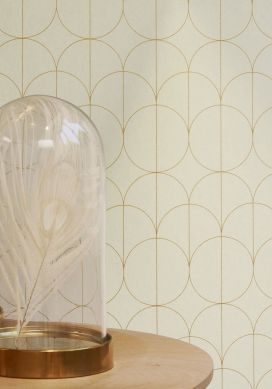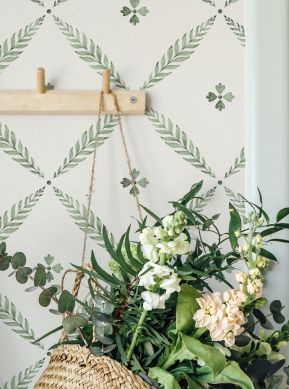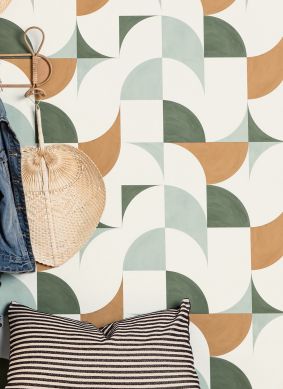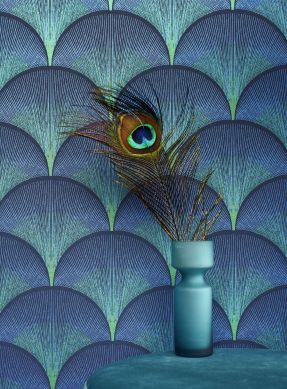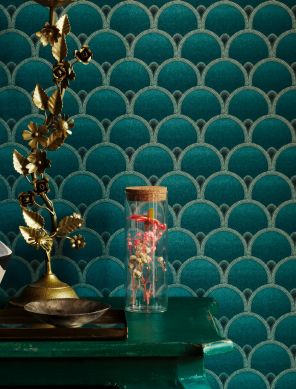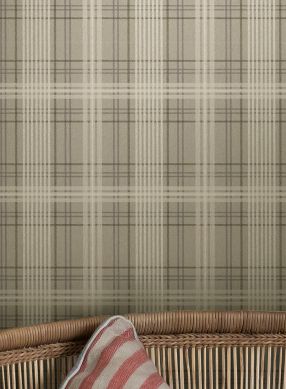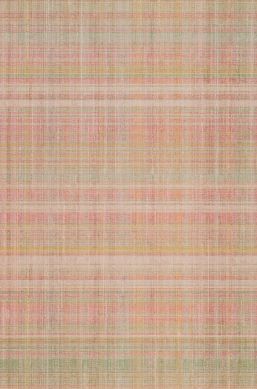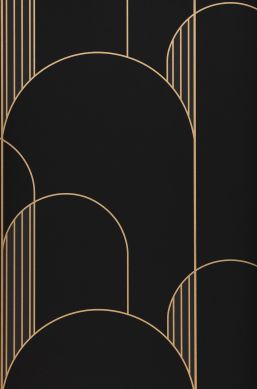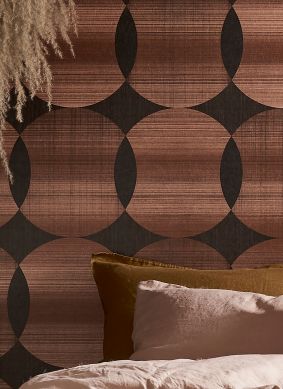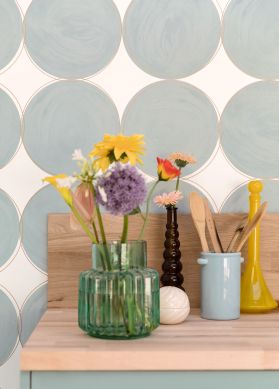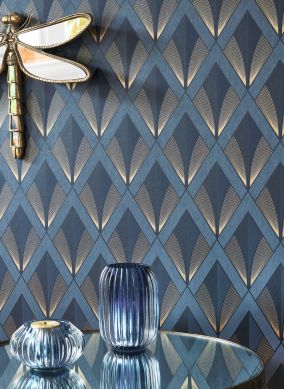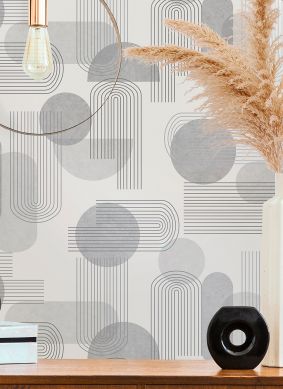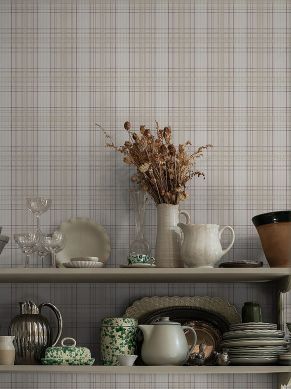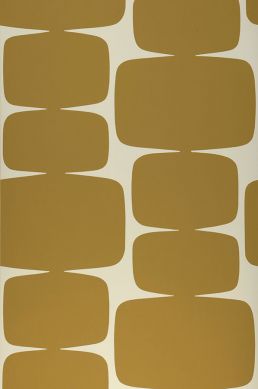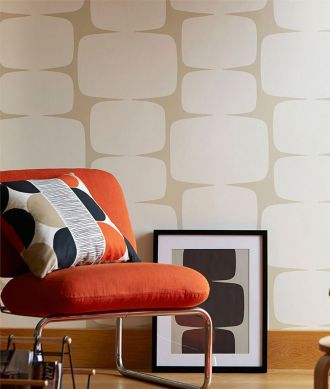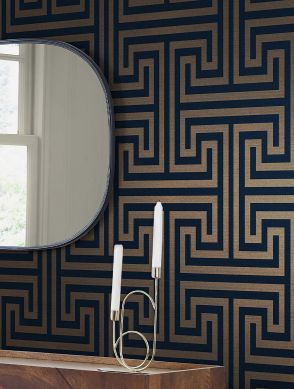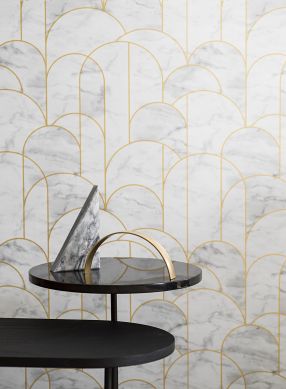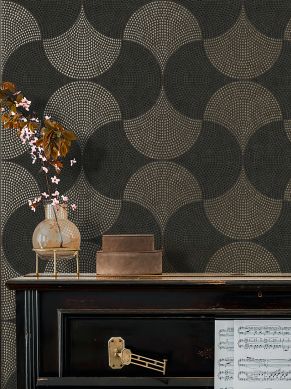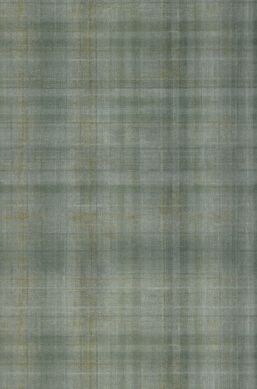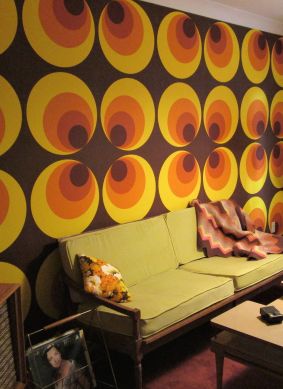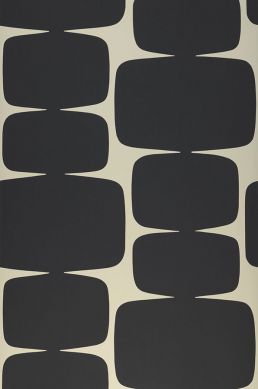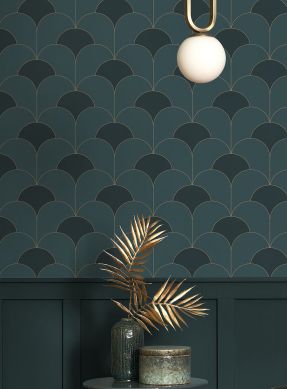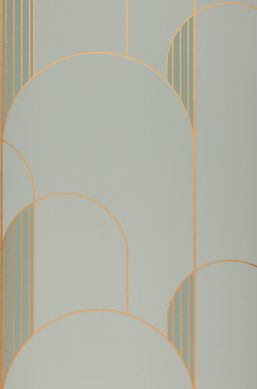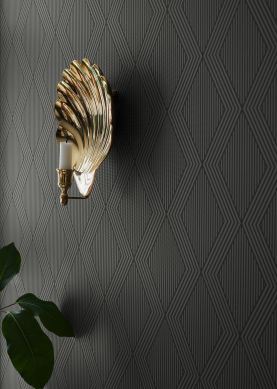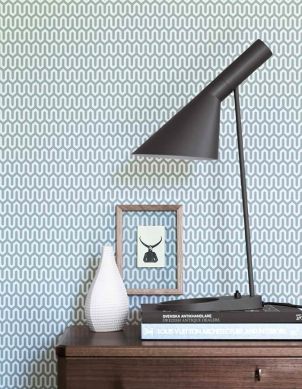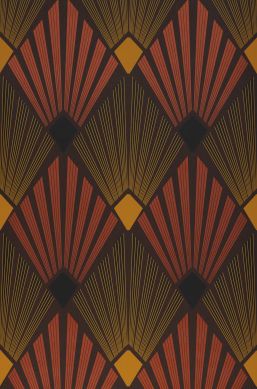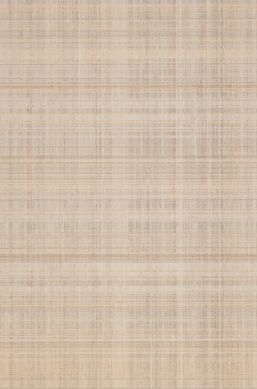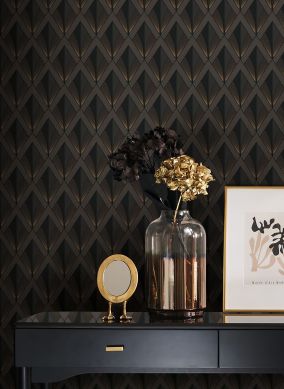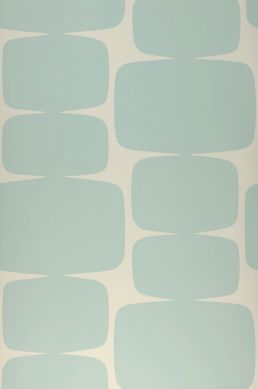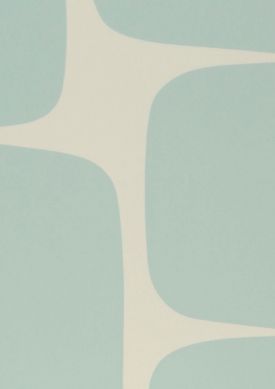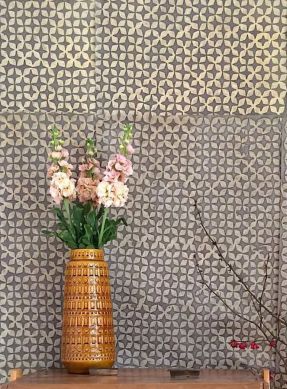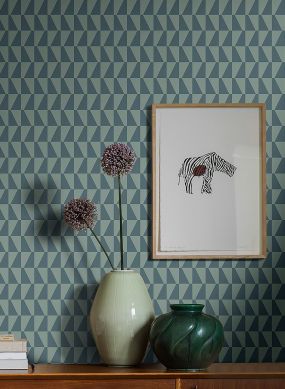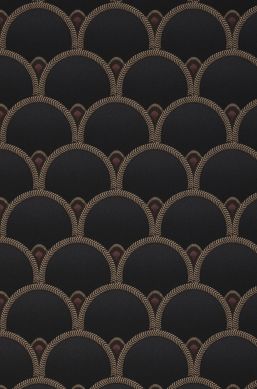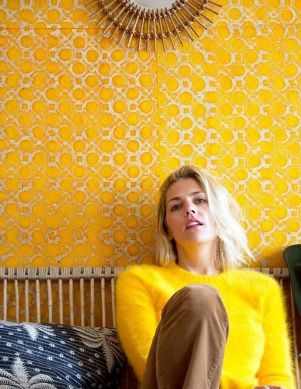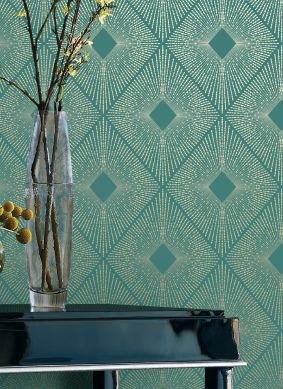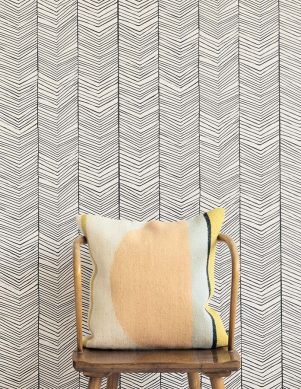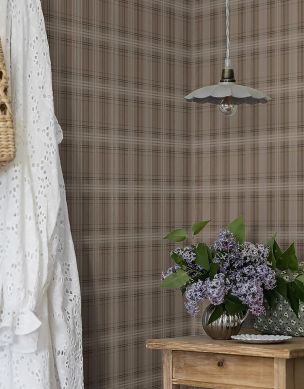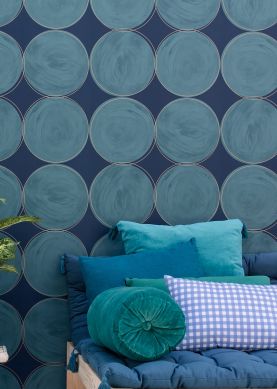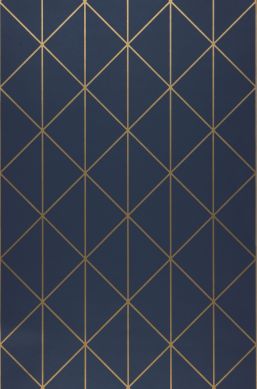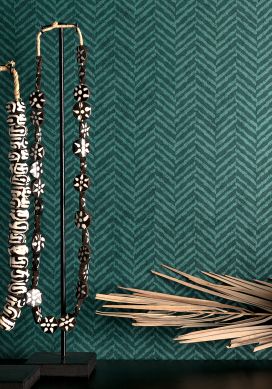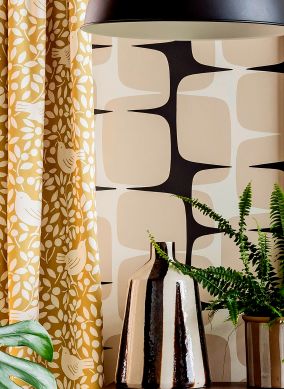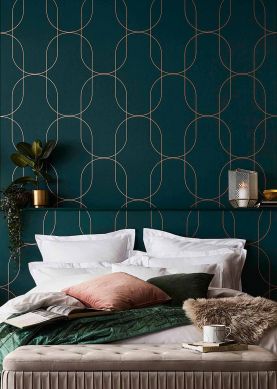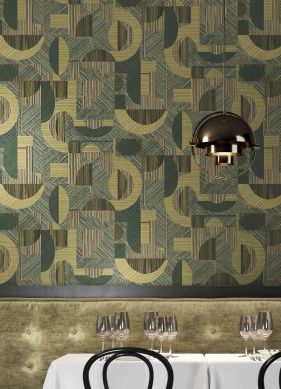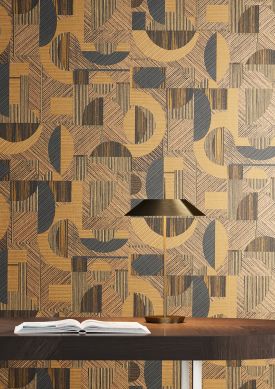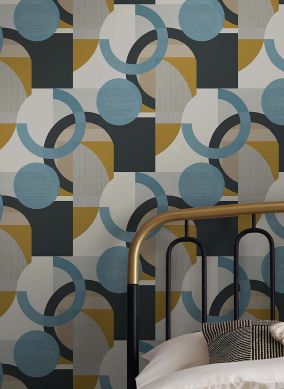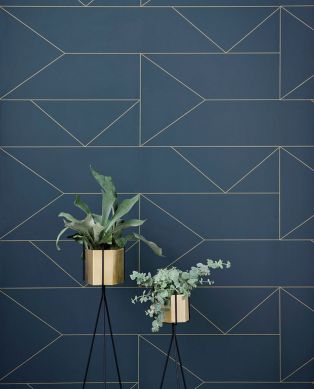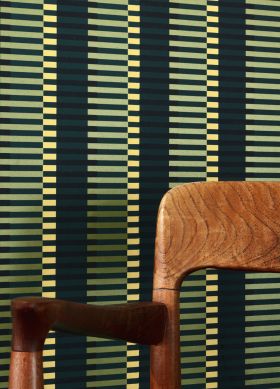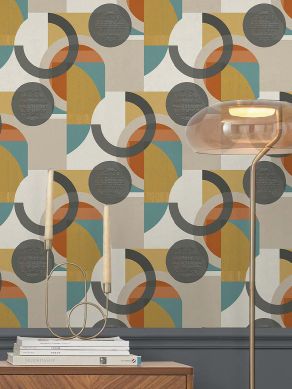Geometric Wallpaper
Geometric & Graphic Wallpaper: The Guide
Geometric shapes present themselves everywhere, for instance on walls, furniture or objects of daily use. For architects and designers, they are part and parcel of their professional life. In the world of art, geometry is the basis for all objective drawings, and entire art styles focus on it, e.g. Op Art. Geometric wallpaper is characterised by a fascinating simplicity, but also a sense of transformability and illusion. Graphic motifs are extremely versatile, and as a result, children and adults like wallpaper models with geometric patterns in equal measure.
Table of Contents
- Which geometric shapes are suitable for wallpaper?
- Which impact do symmetrical and asymmetrical motifs have on geometric and graphic wallpaper patterns?
- Which interior design and wallpaper styles are suitable for geometric patterns?
- Why should abstract geometric patterns only be used for feature walls?
- What are the most popular colours for geometric and graphic wallpaper?
- Which rooms are particularly suitable for geometric wallpaper patterns?
- Why are geometric and graphic wallpaper models so popular?
- Which artists have designed and focused on geometric patterns?
- Our tips: How to make geometric wallpaper irresistible
Which geometric shapes are suitable for wallpaper?
Geometric shapes can create fabulous patterns simply through repeating an element or using a variety of sizes. A few basic shapes (circles, squares, triangles, rhombuses or hexagons) can be sufficient to achieve this effect.
Circles
In terms of wallpaper design, the choice of circles is extremely varied. Closed circles, semi-circles, three-quarter circles, partially open, disrupted or dotted circles are all options. Circles can surround rhombus shapes or create movement when set within squares and cubes. Colours, structures and pattern fillings add to the variety of designs. This pleasing shape without any edges or corners promotes a sense of harmony and balance.
Dots
Thick, thin, small, large, drawn by hand, dotted with a brush, with uneven or totally linear edges - points and dots appear in a plethora of variations on geometric wallpaper models. They exude fresh energy and playfulness. Depending on the choice of colour, they may remind us of confetti or 1950s polka dots.
Squares and rectangles
As pattern elements, squares often have a clear, strong effect. Squares are the basis for the popular chess pattern which in wallpaper designs frequently comes in a variety of colours (rather than just black and white). They form an impactful connection with triangular and rhombus shapes as well as lines and stripes. The possibilities are varied and often depend on the style focus. Rectangular shapes work well with striped wallpaper and are extremely effective in tile designs.
Cubes
Wallpaper models with a 3D effect and optical illusion characteristics often feature cubes. Cubes add visual depth and create layers. Combined with carefully selected materials and colours, they provide striking optical illusions or holograms. The combination with other geometric shapes and special colour compositions is typical for optical art (Op Art).
Triangles
The shape of triangles depends on the length of each individual side, and they can form various different pattern constellations. Triangles love the company of rectangles or can be part of a diamond pattern. The choice of colours is a significant factor for the overall effect. Generally speaking, patterns with triangular shapes tend to exude energy and movement.
Rhombuses
Rhombuses are the basis for the harlequin pattern, a popular motif for geometric wallpapers in black and white or pastel hues. This shape is particularly suitable for interlaced motifs which acquire an exciting look via the choice of colours or floral ornaments (e.g. oriental stone patterns). Together with lines and hexagons, they create fascinating labyrinth patterns.
Checks
Check patterns can come in the shape of rhombuses or squares; in the classic variant, criss-crossing horizontal and vertical lines in one or more colour(s) form the typical check pattern. This conservative interpretation is exceedingly popular in England and Scotland and carries a sense of tradition. Surprisingly, however, its origins are to be found in China.
Zigzag
In fashion terms, zigzag patterns are also known as herringbone or chevrons. The pattern consists of straight lines arranged at the same angles so that the ends of the lines form two parallel lines or arcs. Zigzag patterns are amongst the oldest decorative patterns. In terms of wallpaper design, strong colours can give them dynamic movement.
Hexagons
The hexagon is one of the most significant pattern elements of vintage wallpapers in the style of the wild 1970s and often feature in Art Deco wallpaper designs, too. Hexagons stand for departure and futuristic modernity, and geometry wallpaper models with this popular pattern are always an eye-catcher.
Lines
Lines are graphic patterns in their own right, but can often be found in combination with other geometric shapes, for instance as a means of accentuation and emphasis, or as connecting or disconnecting elements. Anything is possible - from delicate to strong, from clear to blurred lines. They come in all widths and lengths, sometimes consisting of dots.
Waves and Arches
Wave and arch patterns provide dynamic movement in the room and - depending on the choice of colours - have a multi-dimensional effect. Wave patterns can create optical illusions if repeated evenly. In maritime wallpaper designs, they often symbolise water. Arches are instantly recognisable style elements of Art Deco and Oriental Design.
Which impact do symmetrical and asymmetrical motifs have on geometric and graphic wallpaper patterns?
Constantly repeated pattern elements form symmetric lines; deviations from the classic strict symmetry are called asymmetry. Both variations have an impact on the effect of geometric wallpaper models.
Symmetrical Motifs
If a geometric shape or a graphic element is repeated on one level, it is called a symmetric motif. These elements then form a symmetric group or row. Symmetrical patterns and motifs have a harmonising effect on the eye; they create order and structure.
Asymmetrical Motifs
In asymmetric patterns, the geometric element is not repeated in the same manner - it shows deviations, e.g. differences in lengths, changes in shapes or variations in arrangements. For the eye, asymmetry is interesting and provides movement. Patterns of that nature can distract from uneven surfaces.
Which interior design and wallpaper styles are suitable for geometric patterns?
Geometric patterns are popular design tools for a large variety of interior design styles. They are frequently used in modern, Vintage or Scandinavian looks, to name but a few. Art Deco and Bauhaus styles also benefit from graphic motifs.
Modern styles
Modernity and geometry are close bedfellows. Constantly changing trends and a continuous stream of new geometric pattern ideas, often based on the current artistic zeitgeist, provide a plethora of contemporary interior design concepts. Abstract, understated designs are particularly popular.
Vintage
Vintage wallpaper models from the 1950s to the 1970s frequently featured geometric patterns and abstract shapes which at the time represented a sense of departure and change. The new-found emphasis on design opened the doors for a sometimes slightly bizarre and curious variety of shapes. Hexagons, circles, Op Art constructions, garish colours, metallic effects, and black-and-white psychedelic patterns took centre stage.
Art Deco
Art Deco is a melting pot of geometric and figural shapes with a tendency towards the soft (rather than the harsh or strict).
The typical colours (brown, blue, gold, silver and emerald green) add a warm and sophisticated touch. Graphic wallpapers of this style often feature a very creative and detailed take on geometry.
Bauhaus
The Bauhaus style combines architecture, design, art and functionality. This timeless style is perfect for Clean Chic and modern functionality. Simple symmetric shapes, unusual materials and artisan craft are the basis for buildings, furniture and objects of everyday use in the Bauhaus design style. Bright yellow, blue and red are amongst the most popular Bauhaus colours. In terms of wallpaper design, less is more and only a few elements are needed to create fantastic effects.
Scandinavian
The Scandinavian Look is characterised by its minimalist nature. The essence of this style is light and clear. Rhombuses, lines, waves and triangles are the main pattern elements in Scandi wallpaper and textile design. White often features as the main colour, interspersed with details in powdery rosé, light mint or natural sage and yellow.
Why should abstract geometric patterns only be used for feature walls?
Geometric patterns require plenty of space to unfold their full effect and their artistic aestheticism. A feature wall is simply the best choice for more conspicuous Op Art wallpaper models which might have flicker and/or optical illusion effects.
Aesthetics - like a work of art
Geometric wallpaper can be strikingly artistic and always attracts attention. A feature wall is absolutely sufficient to present the real beauty of a graphic wallpaper. The other walls of the room should be kept in just one colour.
This is the best way to ensure that the geometric pattern presents its full effect.
Op Art with flicker and optical illusion effects
Op Art is characterised by geometric constructions which - depending on arrangement and colour choice - can have flickering and optical illusion effects. This effect intensifies when the eyes fix on the pattern. To avoid overwhelming both eyes and mind, the use of this type of pattern wallpaper should be reduced to a feature wall.
What are the most popular colours for geometric and graphic wallpaper?
The effects of graphic wallpaper models are determined by the choice of colours. Blue, grey, green, gold, metallic, multi-coloured and black-and-white are popular with both designers and consumers.
Blue
From light to dark blue and all the shades inbetween - this cool colour exudes sophisticated serenity and adds a luxurious touch to any ambience. Mixing blue with green shades - e.g. in turquoise - has a revitalising, zesty effect. Geometric wallpaper models in the Art Deco style often feature a dark blue background, creating a strong contrast to a golden pattern.
Grey
In context with geometry designs, this neutral colour - a mixture of black and white - represents modernity and clarity. Grey is a fabulous partner for other (strong or pastel) colours. Shades of grey are also popular in Scandinavian graphic art.
Green
Green is a very frequent choice in graphic wallpaper design. Green symbolises growth, hope and nature. In darker hues, its fresh character can also have a stunning depth. This exciting colour is also present in numerous gorgeous Vintage wallpaper models. Many geometric wallpaper patterns of the 1970s feature the colour green, often in combination with orange and brown.
Gold
Gold emphasises the artistic aspect of many Art Deco and Art Nouveau patterns, lending them a sophisticated and luxurious touch. Sunshine, warmth, glamour, and wealth are all associated with gold, which is why this colour often appears on luxurious graphic wallpaper models. When presented in the right light, golden geometric lines can create eye-catching effects.
Multi-coloured
Choosing brightly coloured or pastel hues determines the effects of geometric wallpaper designs. Bright colour are stimulating, they create a good mood, add variety and foster creativity. Children are particularly fond of colourful graphic wallpaper models with dots and circles.
Black/white
Black and white geometric pattern elements attract the eye and play with our visual sense. Optical illusions - for instance in psychedelic patterns - are one of the possible effects. Black-and-white patterns are modern as well as futuristic. The best known examples of black and white patterns are featured in Op Art designs.
Metallic
Depending on the way the light hits them, metallic colours with iridescent effects create a sense of continuous change and movement. The delicate sheen makes rooms appear larger. Different details in the pattern motif are being emphasised. Targeted lighting accentuates the unique character of a wall decorated with metallic wallpaper.
Which rooms are particularly suitable for geometric wallpaper patterns?
Creative spaces, relaxation areas or representative rooms benefit from suitable geometric wallpaper patterns. Top of the list are bedrooms, bathrooms, dining rooms, hallways and studies/offices.
Bedroom
In order to promote relaxation, the right choice of geometric design and colour(s) is of the utmost significance. Simple one-dimensional shapes (e.g. rhombuses, stripes, polka dots) are best suited, provided that only one of these shapes is represented. White is the perfect base colour, but grey and pastel hues also have a calming effect. Gold and silver details add a sophisticated touch.
Bathroom
Abstract symmetrical or asymmetrical patterns are a great option for bathrooms. Tile or stone look wallpaper models are also a good choice. Brightly coloured or in elegant greens, blues or greys - it's entirely up to you and your personal preferences. Gem colours like emerald green or sapphire blue add a sense of luxury to bathrooms.
Dining room
As we all know: We eat with our eyes, too. Geometric pattern designs in dining rooms can be eye-catching, artistic and three-dimensional, perhaps even feature an optical illusion. Colours are a must. Rich shades of red promote appetite, pleasure and conviviality. A geometric wallpaper with vinyl coating can even be wiped with a damp cloth (just in case of any food spillages...).
Hallway
As entry and passage area, the hallway has a representative character. Depending on the size, length and (natural) light conditions, classic line and stripe designs, unusual or funky graphic designs which are easy to take in whilst passing are all great choices. Those who like it a bit less conspicuous might opt for just wallpapering the cloakroom furniture.
Office
Geometric patterns can have a calming effect, but they can also stimulate creative ideas. The type of work conducted in an office determines which wallpaper designs are suitable. It makes sense to decorate the wall one looks at from one's desk. Black-and-white patterns are a very modern option, as they can be both relaxing or stimulating, depending on the specific motif.
Why are geometric and graphic wallpaper models so popular?
The simplicity of perception is just as much a reason for their popularity as their modern and simultaneously playful character. In addition, graphic wallpaper is a fantastic contrast style tool.
Simplicity for the eyes
Our eyes are tuned in to geometry in everyday life and benefit from the simplicity of geometric patterns. Even complex shape constellations and abstract concepts do not overwhelm the viewer as the basic structure is immediately recognisable. One of the shapes to mention in this context is the triangle, especially because its popularity has increased steadily in recent years.
Modern yet playful
Geometric wallpaper patterns aren't tied to just one style. They have a timelessly modern quality, even in Retro wallpaper models. There is a veritable plethora of possible combinations, and this fabulous changeability gives these patterns a charming playfulness, particularly in the sense of agile movement.
Effective contrast tool in interior design
Circles, arches, dots or waves provide a stunning contrast to the straight rectangular lines of furniture. On the other hand, angular shapes and three-dimensional graphic patterns are especially noticeable in wallpapers if they are otherwise scarcely present in the room. 3D wallpaper patterns can also create spatial effects in the room.
Which artists have designed and focused on geometric patterns?
Representatives of many different art forms have paid homage to geometry at some point in their lifetime. Amongst them are Kandinsky, Klee, Miró, Picasso and Vasarely, and each of these artists used geometric elements in a very different way.
Vasily Kandinsky
Russian painter and graphic artist Vasily Kandinsky is one of the most famous representatives of Expressionism and even taught at the Weimar Bauhaus school. His geometric (abstract) works of art often have a melodious, musical character. His form idiom merges lightness and strictness; his chosen colours are of significance for the shapes that Kandinsky re-defines.
Paul Klee
Swiss painter Paul Klee's artistic œuvre combines a number of genres, e.g. Cubism, Constructivism, Expressionism, and Surrealism, all of which incorporate some geometric shapes. Klee makes use of the geometric form idiom to create abstract landscapes, stories and likenesses in his colourful paintings. Each of his works exudes its own dynamism.
Joan Miró
Spanish artist Joan Miró is regarded as an eminent representative of Classic Modernism. He utilised geometric shapes to create the symbols of his own, instantly recognisable imagery, for instance woman, moon, eye. Miró's approach to geometry is soft, fluid, it does not stick religiously to straight lines, it breaks boundaries. Familiar shapes are used to create new, unfettered elements. Red, blue, yellow, green, white and black are the dominant hues in the artist's colour concept.
Pablo Picasso
The world-famous Spaniard was a truly multi-talented artist. His painting "Les Demoiselles d’Avignon" (1907) is considered to have signalled the birth of Cubism. The name of this style is derived from the Latin word "Cubus" (cube). Its main characteristic is the depiction of objects and persons in the shape of geometric forms like spheres, cones and pyramids.
Victor Vasarely
The French painter and graphic artist with Hungarian roots is one of the co-founders of Op Art. Abstract shape patterns as well as geometric colour figures are designed in such a way that they trigger various effects such as flickering, movement or optical illusion in the viewer. Vasarely's preferred shapes were squares, rhombuses, triangles, circles, lines and waves.
Our tips: How to make geometric wallpaper irresistible
- Decorating doors with geometric wallpaper: Doors are always in view and as such predestined for graphic designs. Pay attention to the pattern size and match the colours to the rest of the room design.
- Combination with warm wooden furniture: Almost every geometric pattern motif benefit from warm wooden furniture. These may reflect the shapes of the wallpaper design or deliberately set a strong contrast.
- Bedroom Black & White Double Action: Give the bedroom an unusual touch by choosing wallpaper with a black and white diamond or zigzag pattern for the bed headboard and the longitudinal wall to the right. Decorate the left longitudinal wall with a striped wallpaper in black and white. Furniture and furnishings should also kept in black and white.
- The staircase as a modern gallery: Walls along the staircase can be brought into focus with an eye-catching graphic design. If two walls face each other, only one should be decorated with geometric wallpaper.


